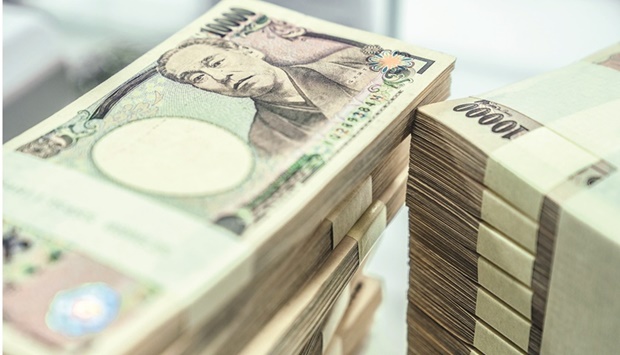The yen slumped past the key psychological level of 140 per dollar for the first time in almost a quarter of a century, a move that may extend as the divergence between US and Japanese monetary policy widens.
Fuelled in large part by the rise in Treasury yields, the yen fell as much as 0.9% against the dollar on Thursday, extending its year-to-date decline to almost 18%. And options markets show traders are betting there might be more to come, with pricing skewed toward contracts that will pay off if dollar-yen keeps rising.
The slide in the yen - the worst performer this year among Group-of-10 currencies - reflects a growing split between the Bank of Japan (BoJ), which is keeping policy loose to bolster the economy, and a Federal Reserve that has been at pains to stress its inflation-fighting bona fides.
While BoJ boss Haruhiko Kuroda has shown little inclination to move interest rates away from near-zero levels or dial back other unconventional policies, Treasury yields have been rising in the wake of the recent Jackson Hole Symposium amid speculation that the Fed will this month enact its third-straight three-quarter-point rate hike.
The resulting widening yield gap between the US and Japan has been a big driver in yen weakness, as it encourages investors to seek out the more attractive returns in dollar assets from money market instruments to fixed-income securities compared to Japanese ones.
“The yen is fast becoming the world’s only zero-yielding currency,” JPMorgan Chase & Co strategists Benjamin Shatil and Sosuke Nakamura wrote in a note to clients on Thursday. “The barrage of hawkish Fed rhetoric post-Jackson Hole, retreat in US recession risk, and apparently unwavering dovish commitment from Kuroda, should leave dollar-yen hostage.”
A combination of improving economic data and the Fed’s hawkish approach has helped push a Bloomberg index of the dollar’s strength to the highest on record, with the gauge on Thursday eclipsing the previous peak from July. Recent trading in the dollar-yen pair underscores the widening economic gulf between the US and Japan as policy makers contend with a highly uncertain outlook.
The yen’s drop is also being stoked by high import prices that are upsetting the usual balance of trade.
Japan has so far declined to intervene in the currency markets to arrest the depreciation of its currency, and officials may have a disincentive to do so since a weaker yen may help the economy by making the nation’s exports more competitive.
Indeed, comments Friday from Finance Minister Shunichi Suzuki suggested no significant increase in cautionary language.
“I have the impression recent moves in the exchange rate have become fairly large,” he told reporters. “The government will continue to monitor developments in the foreign exchange market with a high sense of urgency.” The government has intervened before, of course. It did so back in 1998 to prop up the currency at around the same time much of Asia was being buffeted by a regional financial crisis. That year was also the last time the yen was close to current levels versus the dollar.
“Authorities are likely to stick to verbal warning for now but since 140 levels are one key milestone, they may raise the level of wariness,” said Shinsuke Kajita, chief strategist at Resona Holdings in Tokyo. “While there may be doubts about the effectiveness of intervention, market players are likely to pay a degree of respect to Japanese authorities’ verbal warning and that will weigh on USD/JPY.”
The yen traded around 140.10 in Tokyo Friday. An options market gauge of expected direction in the dollar-yen - three-month risk reversals - suggested traders see the pair pushing higher over that time frame. Outside of direct intervention, a sustained rebound for the yen would require the BoJ to implement significant rate increases, which would take a major toll on the economy, said Steven Englander, head of Group-of-10 currency research at Standard Chartered.
Yet it doesn’t look like any such action is on the immediate horizon, with Kuroda last week emphasising in his appearance at Jackson Hole that he plans to stick with the BoJ’s current approach.
“Halting the yen’s decline would take a shift in rates policy by the BoJ, and they have been adamant so far that getting inflation sustainably to target is their goal,” said Englander, who thinks the yen is undervalued at current levels.
“The yen weakness is being driven by an artificially low interest rate compared to everyone else, and there’s the question of how far can it really go.”

Bundles of Japanese yen banknotes. The yen slumped past the key psychological level of 140 per dollar for the first time in almost a quarter of a century, a move that may extend as the divergence between US and Japanese monetary policy widens.
